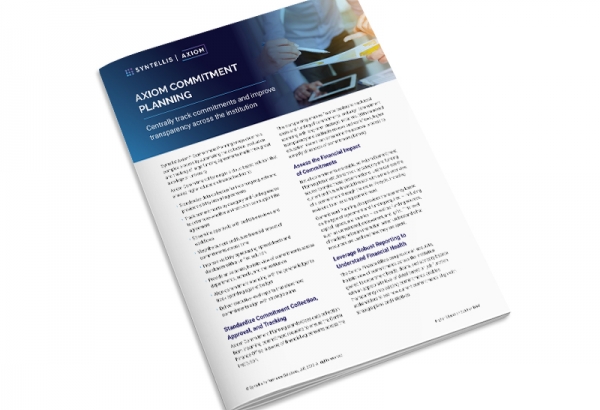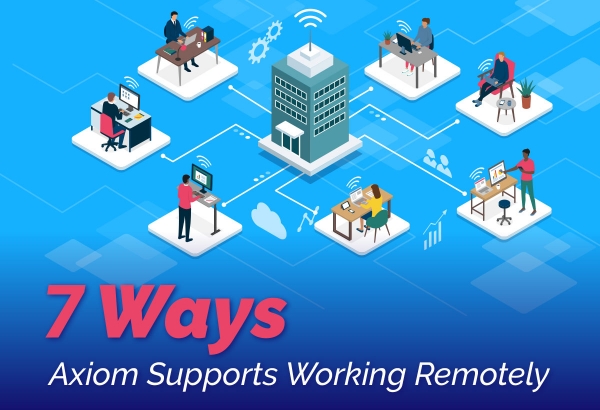Like many higher education institutions, Emory University School of Medicine (SOM) struggled with commitment planning, from tracking the commitments made across the school to visualizing the funding sources and understanding how financial resources are allocated.
In 2019, Emory University’s SOM leaders partnered with Syntellis Performance Solutions to begin the transformation of the SOM’s commitment planning and tracking process. The multi-phased project includes development of Syntellis’ Axiom™ Commitment Planning — a single system for capturing, relaying, tracking, and analyzing data related to the school’s commitments and using the data to inform strategy. Phase I was completed in FY2020 and focused on commitment planning. Phase II will address the tracking and analysis with targeted completion in FY2021.
Emory University’s SOM is transforming its commitment planning by:
- Establishing a single source of truth
- Enhancing the ability to track commitments
- Eliminating duplication of effort
- Reducing risk
- Acting with agility when disaster strikes
- Increasing security capabilities
- Creating a sense of partnership between finance and other departments
No. 1: Establishing a single source of truth
The SOM adopted an institution-wide platform for commitment planning that ensured each department had access to the most current data in one place.
“When we’re not using a single system, commitment planning is very challenging,” says Beth Boatwright, CFO, Emory University School of Medicine. “There are problems with version control: Often, department heads would think they were making a decision off the most current data, but they would be using an old spreadsheet. Disagreements over balances would often come down to, ‘Are you looking at the right information?’ Now, in Phase II we will be transitioning existing Excel workbooks to the commitment tracking tool."
"Axiom Commitment Planning will empower us to analyze data, identify trends, and develop a proactive response. It also increases trust in the process.”
No. 2: Enhancing the ability to track requests and approved commitments
At colleges and universities, commitments come in many forms — often with multiple funding sources per commitment. “The challenges are multifold. First, Phase I allowed us to develop a process for tracking commitment requests and approvals. Second, tracking the cascading components of commitments as the chair recruits new candidates is quite difficult,” Boatwright says.
Currently, Emory University SOM relies on departments to track cascading commitments in spreadsheets. “We often are not on the same page as to what the available balance is, which is usually the million-dollar question,” she says. “For instance, if a chair is far along in developing their recruitment package, the question becomes, ‘Do we have enough money to extend the offer to that recruit?’ These discussions also are time-sensitive — the person may have competing offers. If we have to pause because the department and the finance team are not in agreement over what the correct balance is, we lose valuable time. There shouldn’t be scrambling at the eleventh hour or confusion over who’s got the right spreadsheet.”
At the end of Phase II implementation our goal is for Axiom Commitment Planning to enable tracking of commitments, to whom, and how much money is available at any time. “This goes back to the importance of having a single source of truth,” Boatwright says. Advanced software capabilities also help the SOM:
- View extended obligations at a glance
- Determine the spend rate
- See funding sources for extended obligations
- Understand the potential yield of commitments
- Model cash flow over time
- Support the institution’s growth strategy more effectively
“Getting to these answers requires a continual refresh of the data,” Boatwright says. “Axiom is the only way for us to stay on top of commitments, which represent our biggest extension of money.”
No. 3: Eliminating duplication of effort
Prior to rolling out Commitment Planning, “There was not a defined process for commitment planning,” says Ann Uher, Director of Accounting and Analytics, Emory University School of Medicine. “Everything was done via spreadsheets — some of which were cryptic — and email, and the process varied by department. ‘Side deals’ were made verbally, but they weren’t captured.”
Implementing Commitment Planning brought structure and discipline institution-wide, with a defined process across departments and a clear view of the numbers for budgeting. It also eliminated “spreadsheet fatigue” among staff by providing an easy-to-use tool with valid data and clean reports.
“Now, we’re more strategic in decision-making, such as around recruits, and more methodical in the way we communicate decisions to chairs,” Uher says.
No. 4: Reducing risk
There is a risk component associated with cumbersome commitment planning and tracking. One is the risk that an institution will lose a potential new hire because of decision paralysis, which occurs when institutions take too long to make an offer and the candidate accepts an offer elsewhere.
“Conversations regarding new recruits are not small or quick; they usually take place over long periods of time. When a chair is ready to recruit a specific candidate, you have to move quickly, and that’s difficult if you don’t know how much money you have to work with,” Boatwright says.
Breakdowns in commitment planning and tracking processes also increase the risk that institutions will make decisions based on inaccurate data. Axiom Commitment Planning will give stakeholders access to accurate data in real time so SOM leaders can make faster, data-driven decisions.
No. 5: Acting with agility when disaster strikes
Emory SOM had just submitted its 2021 budget when COVID-19 emerged in the United States. Commitment Planning allowed for a quick, nimble review and adjustment to approved budget status. The solution enabled Emory SOM to place requests on hold while maintaining the integrity of the original request for review as COVID-19 conditions changed.
“Our Chief Business Officer commended us recently for the ease with which we changed course,” Boatwright says.
“In the past, it would have been an excruciating exercise to redo our budget, and we probably would have tried to avoid it. This year, it was almost a non-event given the capabilities in the software. Axiom was a game-changer.”
No. 6: Increasing security capabilities
“Our other systems inside Emory are open systems, which means anyone can log in and see anyone else’s information,” Boatwright says. “When it comes to commitments, you want to limit the visibility to individual packages. We needed to tightly secure this information, and the software gives us that capability. That’s one reason why we knew Axiom was the right solution for us: It possessed the security features that we couldn’t have achieved in any other platform.”
No. 7: Creating a sense of partnership between finance and other departments
“The end users really like the Phase I component of this tool, and they’ve gained a lot of confidence, which makes the planning process smoother,” Boatwright says. “We look forward to building on that traction and the spirit of partnership as we implement additional phases of this tool.”
Your peers also read...

Axiom Commitment Planning

7 Ways Axiom Supports Working Remotely


